Publié le 25 janvier 2021
A research team – the first to carry out a survey of global ice loss using satellite data – has discovered that the rate at which ice is disappearing across the planet is speeding up. The findings also reveal that 28 trillion tonnes of ice was lost between 1994 and 2017 – equivalent to a sheet of ice 100 metres thick covering the whole of the UK.
A paper, published today in The Cryosphere, describes how a team of researchers led by the University of Leeds in the UK used information from ESA’s ERS, Envisat and CryoSat satellites as well as the Copernicus Sentinel-1 and Sentinel-2 missions to find that the rate at which Earth has lost ice has increased markedly within the past three decades, from 0.8 trillion tonnes per year in the 1990s to 1.3 trillion tonnes per year by 2017.
To put this into perspective, one trillion tonnes of ice can be thought of as a cube of ice measuring 10x10x10 km, which would be taller than Mount Everest.
 — In perspective: 1 trillion tonnes of ice
— In perspective: 1 trillion tonnes of ice
The research shows that overall, there has been a 65% increase in the rate of ice loss over the 23-year survey. This has been driven mainly by steep rises in losses from the polar ice sheets in Antarctica and Greenland.